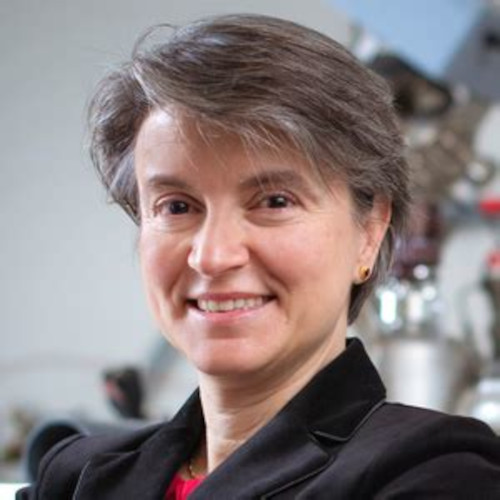Ralf Drautz
Ruhr Universität and ICAMS Bochum, Germany
Geometry, topology and atomic interactions - from fundamentals to accurate and efficient simulations
 Recent advances in machine learning interatomic potentials promise large atomistic simulations at an accuracy close to density functional theory. While seminal work in the field employed descriptors as input for machine learning energies and forces, more recently formally complete representations of atomic configurations were developed. These allow one to understand machine learning potentials from few, unifying considerations and to incorporate guidance from physics and chemistry. In my talk I will give an overview of the field from the perspective of the atomic cluster expansion. The atomic cluster expansion is general and can represent local and semilocal interactions. It is modular and incorporates magnetism, charge, vectorial and tensorial quantities. It further lends itself to sparse representations necessary for universal force fields. I will demonstrate recent progress with simulations for carbon, hydrogen, water and alloys. I will further address open challenges and make suggestions how these could be overcome.
Recent advances in machine learning interatomic potentials promise large atomistic simulations at an accuracy close to density functional theory. While seminal work in the field employed descriptors as input for machine learning energies and forces, more recently formally complete representations of atomic configurations were developed. These allow one to understand machine learning potentials from few, unifying considerations and to incorporate guidance from physics and chemistry. In my talk I will give an overview of the field from the perspective of the atomic cluster expansion. The atomic cluster expansion is general and can represent local and semilocal interactions. It is modular and incorporates magnetism, charge, vectorial and tensorial quantities. It further lends itself to sparse representations necessary for universal force fields. I will demonstrate recent progress with simulations for carbon, hydrogen, water and alloys. I will further address open challenges and make suggestions how these could be overcome.
Monday, September 23 | 8:20-9:00 AM
Forum Hall
Christopher Wolverton
Northwestern University, USA
Short-Range Order in High-Entropy Materials
 Short-range order (SRO) in multicomponent alloys is complicated by the number of components, e.g., the number of Warren-Cowley SRO parameters for an M-component alloy is M(M-1)/2. Computational tools such as cluster expansion and machine-learned interatomic potential simulations, can be used to obtain SRO parameters, but these methods are too computationally expensive to survey a wide range of compositions in a high-throughput manner. In an effort to find high-throughput descriptors of SRO, we analyze the connection between SRO and LRO/phase diagrams for multicomponent alloys, and also investigate whether multicomponent SRO can be inferred from lower order (e.g., binary, ternary) information. We find that SRO cannot be determined from considerations of LRO alone, but the two can even qualitatively disagree. Based on energetics of ordered, disordered, and coherent phase separated states, we determine simple energetic descriptors of SRO, allowing us to classify SRO types in a variety of high-entropy alloy systems. We show illustrations of these ideas in high-entropy alloys with applications as structural materials, battery cathodes, and thermoelectrics.
Short-range order (SRO) in multicomponent alloys is complicated by the number of components, e.g., the number of Warren-Cowley SRO parameters for an M-component alloy is M(M-1)/2. Computational tools such as cluster expansion and machine-learned interatomic potential simulations, can be used to obtain SRO parameters, but these methods are too computationally expensive to survey a wide range of compositions in a high-throughput manner. In an effort to find high-throughput descriptors of SRO, we analyze the connection between SRO and LRO/phase diagrams for multicomponent alloys, and also investigate whether multicomponent SRO can be inferred from lower order (e.g., binary, ternary) information. We find that SRO cannot be determined from considerations of LRO alone, but the two can even qualitatively disagree. Based on energetics of ordered, disordered, and coherent phase separated states, we determine simple energetic descriptors of SRO, allowing us to classify SRO types in a variety of high-entropy alloy systems. We show illustrations of these ideas in high-entropy alloys with applications as structural materials, battery cathodes, and thermoelectrics.
Tuesday, September 24 | 8:30-9:10 AM
Forum Hall
Claire Wilhelm
Curie Institute & CNRS, France
Magnetic Instructive Tools to Engineer and Stimulate Model Tissues
 While magnetic nanoparticles paved the way in nanomedicine to tailor-made therapeutic prescriptions and theranostics functionalities, their use as a tool for tissue engineering opens up challenging perspectives that have yet been more rarely explored. To create organized cellular 3D artificial tissues, it is necessary to manipulate the component cells remotely to make them interact and self-organize. Magnetic forces acting at a distance are appealing candidates, provided the individual cells are first rendered magnetic by internalization of iron oxide nanoparticles. The magnetism of such internalized nanoparticles then provide the cells with sufficient magnetization to manipulate them, leading the way to magnetic-based methods to provide magnetic artificial tissue replacements, that can be stimulated on demand. For instance, it could induce mechanically stem cells differentiation. Similarly, it allows to magnetically compress cancer spheroids alongside their genesis or drug testing and even nanoparticles-mediated therapy. The therapeutic use of nanoparticles regenerative medicine application still raises the more general issue of intracellular nanoparticle long-term fate. Cell spheroids models and magnetic tools were developed to monitor long-term nanomaterials intracellular integrity, evidencing intracellular degradation of the magnetic nanoparticles. Remarkably, human cells could also biosynthesize their own magnetic nanoparticles, with longer persistence, and limited toxicity.
While magnetic nanoparticles paved the way in nanomedicine to tailor-made therapeutic prescriptions and theranostics functionalities, their use as a tool for tissue engineering opens up challenging perspectives that have yet been more rarely explored. To create organized cellular 3D artificial tissues, it is necessary to manipulate the component cells remotely to make them interact and self-organize. Magnetic forces acting at a distance are appealing candidates, provided the individual cells are first rendered magnetic by internalization of iron oxide nanoparticles. The magnetism of such internalized nanoparticles then provide the cells with sufficient magnetization to manipulate them, leading the way to magnetic-based methods to provide magnetic artificial tissue replacements, that can be stimulated on demand. For instance, it could induce mechanically stem cells differentiation. Similarly, it allows to magnetically compress cancer spheroids alongside their genesis or drug testing and even nanoparticles-mediated therapy. The therapeutic use of nanoparticles regenerative medicine application still raises the more general issue of intracellular nanoparticle long-term fate. Cell spheroids models and magnetic tools were developed to monitor long-term nanomaterials intracellular integrity, evidencing intracellular degradation of the magnetic nanoparticles. Remarkably, human cells could also biosynthesize their own magnetic nanoparticles, with longer persistence, and limited toxicity.
Tuesday, September 24 | 9:10-9:50 AM
Forum Hall
Bilge Yıldız
Massachusetts Institute of Technology, USA
Uncovering Fast Proton Conductors Based on Lattice Dynamics
 Achieving high proton conductivity in inorganic solids is key for many electrochemical technologies, such as energy-efficient fuel cells and electrolyzers, proton batteries, and low-energy nanoelectronics. A quantitative understanding of the physical traits of a material that regulate the Grotthuss mechanism of proton diffusion is necessary for accelerating the discovery of new proton conductors in these technologies. We have mapped the structural, chemical, and dynamic properties of solid acids and ternary metal oxides to the mechanistic steps of proton diffusion, by performing ab initio molecular dynamics, phonon spectra and atomic structure calculations. We have identified the donor–hydrogen bond lengths and as key descriptors of local proton hopping, and select rigid unit phonon modes frequencies as the key descriptor of lattice flexibility. Lattice flexibility facilitates reorganization of the lattice as the proton is transferred from the donor to the acceptor sites. In solid acids, lattice flexibility manifests itself as the extent of the polyanion group rotations, and in ternary oxides as the flexibility of the lattice to bring donor and acceptor sites (oxygen pairs) close to each other dynamically by leveraging certain phonon modes. The lattice flexibility also correlates with the superprotonic transition temperature. Using these descriptors, we have identified potential solid acid proton conductors, which go beyond the traditionally considered monovalent alkali cations in solid acids. Overall, our results indicate to the importance of lattice flexibility in increasing proton conductivity in inorganic compounds.
Achieving high proton conductivity in inorganic solids is key for many electrochemical technologies, such as energy-efficient fuel cells and electrolyzers, proton batteries, and low-energy nanoelectronics. A quantitative understanding of the physical traits of a material that regulate the Grotthuss mechanism of proton diffusion is necessary for accelerating the discovery of new proton conductors in these technologies. We have mapped the structural, chemical, and dynamic properties of solid acids and ternary metal oxides to the mechanistic steps of proton diffusion, by performing ab initio molecular dynamics, phonon spectra and atomic structure calculations. We have identified the donor–hydrogen bond lengths and as key descriptors of local proton hopping, and select rigid unit phonon modes frequencies as the key descriptor of lattice flexibility. Lattice flexibility facilitates reorganization of the lattice as the proton is transferred from the donor to the acceptor sites. In solid acids, lattice flexibility manifests itself as the extent of the polyanion group rotations, and in ternary oxides as the flexibility of the lattice to bring donor and acceptor sites (oxygen pairs) close to each other dynamically by leveraging certain phonon modes. The lattice flexibility also correlates with the superprotonic transition temperature. Using these descriptors, we have identified potential solid acid proton conductors, which go beyond the traditionally considered monovalent alkali cations in solid acids. Overall, our results indicate to the importance of lattice flexibility in increasing proton conductivity in inorganic compounds.
Wednesday, September 25 | 8:00-8:40 AM
Forum Hall
Bob Coecke
Quantinuum Ltd. UK & Perimeter Institute, Canada
From Quantum in Pictures to Quantum Advantage for Interpretable AI
 This talk requires no particular technical background. We start with an overview of the history of the quantum formalism and fundamental quantum concepts, leading into the quantum picturalism program, the use of which has recently become wide-spread in quantum industry. At the same time, we report on compelling empirical evidence on its educational value. Meanwhile, some governments around the world are already starting to adopt Quantum in Pictures as a basis for secondary school quantum education. One particular new application that has emerged from quantum picturalism is interpretable quantum AI. Basically, linguistic structures have canonical representations as quantum processes: one could say that language is quantum-native, a bit like chemistry. The same analogy also has resulted in BQP-hard quantum algorithms for things like question-answering. We also have experimental demonstrations of these on our H2 quantum computers, where in particular we witness “compositional generalisation” when training, hence avoiding issues many QML approaches have to deal with. We end with a musical note.
This talk requires no particular technical background. We start with an overview of the history of the quantum formalism and fundamental quantum concepts, leading into the quantum picturalism program, the use of which has recently become wide-spread in quantum industry. At the same time, we report on compelling empirical evidence on its educational value. Meanwhile, some governments around the world are already starting to adopt Quantum in Pictures as a basis for secondary school quantum education. One particular new application that has emerged from quantum picturalism is interpretable quantum AI. Basically, linguistic structures have canonical representations as quantum processes: one could say that language is quantum-native, a bit like chemistry. The same analogy also has resulted in BQP-hard quantum algorithms for things like question-answering. We also have experimental demonstrations of these on our H2 quantum computers, where in particular we witness “compositional generalisation” when training, hence avoiding issues many QML approaches have to deal with. We end with a musical note.
Wednesday, September 25 | 8:40-9:20 AM
Forum Hall
Tomáš Jungwirth
Institute of Physics of the CAS, Czechia & University of Nottingham, UK
Altermagnets and unconventional magnetism
 Mutual interaction of magnets via their magnetic fields is the reason why we know them for millenia and was the basis of the 19th century analog and 20th century digital magnetic recording. Today, however, ferromagnetic bits in advanced chip technologies use transport of electron spins instead of magnetic field for reading and writing, turning the magnetic field from a friend into a foe that principally limits further scalability of magnetic information technologies. A solution would be magnets that deliver the same bit functionalities without having a magnetization. Physically, this requires a discovery of new unconventional magnetic phases with alternating sign of the spin-polarization in the electronic structure, analogous to the alternating sign of the Cooper-pairing gap function in p-wave superfluid 3He or d-wave supercoducting cuprates. The parity-breaking p-wave or anisotropic d-wave ordered phases lower the real-space symmetry with respect to the normal state of the interacting electron fluid. Such a symmetry lowering, commonly considered to be promoted by strong electronic correlations, is rare and in magnetism has been elusive until recently. In this talk we will present recent discovery of the magnetic counterparts of the d-wave superconductivity - the so called altermagnets, and of the magnetic counterparts of p-wave superfluidity. Remarkably, the unconventional symmetry lowering is promoted by certain crystal symmetries rather than strong electronic correlations which makes the identified unconventional magnets robust and abundant. We will discuss fundamental physics of the unconventional magnets, initial experimental evidence, and their prospect in information technologies.
Mutual interaction of magnets via their magnetic fields is the reason why we know them for millenia and was the basis of the 19th century analog and 20th century digital magnetic recording. Today, however, ferromagnetic bits in advanced chip technologies use transport of electron spins instead of magnetic field for reading and writing, turning the magnetic field from a friend into a foe that principally limits further scalability of magnetic information technologies. A solution would be magnets that deliver the same bit functionalities without having a magnetization. Physically, this requires a discovery of new unconventional magnetic phases with alternating sign of the spin-polarization in the electronic structure, analogous to the alternating sign of the Cooper-pairing gap function in p-wave superfluid 3He or d-wave supercoducting cuprates. The parity-breaking p-wave or anisotropic d-wave ordered phases lower the real-space symmetry with respect to the normal state of the interacting electron fluid. Such a symmetry lowering, commonly considered to be promoted by strong electronic correlations, is rare and in magnetism has been elusive until recently. In this talk we will present recent discovery of the magnetic counterparts of the d-wave superconductivity - the so called altermagnets, and of the magnetic counterparts of p-wave superfluidity. Remarkably, the unconventional symmetry lowering is promoted by certain crystal symmetries rather than strong electronic correlations which makes the identified unconventional magnets robust and abundant. We will discuss fundamental physics of the unconventional magnets, initial experimental evidence, and their prospect in information technologies.
Thursday, September 26 | 8:00-8:40 AM
Forum Hall
Hyoung Seop Kim
Pohang University of Science and Technology (POSTECH), South Korea
Advancements in Heterostructured Materials by Integrating Theory, Modeling, Machine Learning, and Microstructural Analysis
 This presentation synthesizes insights from innovative studies on the design and analysis of heterogeneous microstructures in materials, focusing on enhancing mechanical properties such as strength and ductility. This research utilizes a representative volume element modeling approach to accurately control specific microstructural features, particularly in core-shell structures. By applying the finite element method alongside a dislocation-based constitutive model, the deformation behavior is elucidated, emphasizing the design of optimal heterogeneous microstructures based on the interplay of geometry, size, and shape within soft and hard domains. Building on this foundation, the study introduces an integrated approach, combining three-dimensional numerical modeling with machine learning techniques, to design a Harmonic Structured Material (HSM). This innovative methodology incorporates hetero-deformation induced (HDI) strengthening features and Bayesian inference, resulting in a predictive framework that identifies the optimal microstructure for superior mechanical performance. The study demonstrates the potential of machine learning in expanding the data pool for material design, leading to the successful fabrication of a new HSM with enhanced properties. This study also focuses on the bimodal structure-property linkage, developing a physical-based constitutive model that captures the deformation mechanism considering the evolution of dislocation densities. Through microstructure-based FEM simulations, this research provides a quantitative analysis of the complex correlations between grain size, volume fraction, and spatial distribution in bimodal structures, facilitating the discovery of optimal heterogeneous equiaxed bimodal structures. Collectively, these studies represent a comprehensive approach, merging advanced computational modeling, empirical analysis, and machine learning, to push the boundaries of material science in designing materials with tailored mechanical properties for various industrial applications.
This presentation synthesizes insights from innovative studies on the design and analysis of heterogeneous microstructures in materials, focusing on enhancing mechanical properties such as strength and ductility. This research utilizes a representative volume element modeling approach to accurately control specific microstructural features, particularly in core-shell structures. By applying the finite element method alongside a dislocation-based constitutive model, the deformation behavior is elucidated, emphasizing the design of optimal heterogeneous microstructures based on the interplay of geometry, size, and shape within soft and hard domains. Building on this foundation, the study introduces an integrated approach, combining three-dimensional numerical modeling with machine learning techniques, to design a Harmonic Structured Material (HSM). This innovative methodology incorporates hetero-deformation induced (HDI) strengthening features and Bayesian inference, resulting in a predictive framework that identifies the optimal microstructure for superior mechanical performance. The study demonstrates the potential of machine learning in expanding the data pool for material design, leading to the successful fabrication of a new HSM with enhanced properties. This study also focuses on the bimodal structure-property linkage, developing a physical-based constitutive model that captures the deformation mechanism considering the evolution of dislocation densities. Through microstructure-based FEM simulations, this research provides a quantitative analysis of the complex correlations between grain size, volume fraction, and spatial distribution in bimodal structures, facilitating the discovery of optimal heterogeneous equiaxed bimodal structures. Collectively, these studies represent a comprehensive approach, merging advanced computational modeling, empirical analysis, and machine learning, to push the boundaries of material science in designing materials with tailored mechanical properties for various industrial applications.
Thursday, September 26 | 8:40-9:20 AM
Forum Hall

